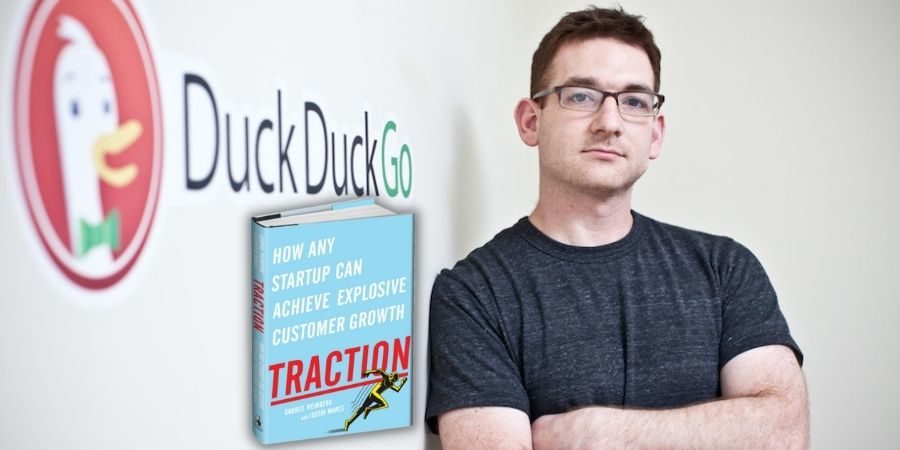Traction by Gabriel Weinberg Summary: Top Takeaways
In “Traction”, Gabriel Weinberg, the founder of search engine Duckduckgo, shares his framework and knowledge on unlocking high growth in startups.
He draws on his experiences and lesons from 40 other successful founders, to give you a step by step playbook anyone can use to find explosive growth for their startup.
Even though this book focuses on startups, this growth framework is useful for any business.
In this traction book summary we’ve outlined the top takeaways we got from the book and have employed to build our own businesses.
Traction
Traction is a sign that your company is taking off and is basically quantitative evidence of customer demand.
A startup is a company designed to grow fast and you grow fast by getting traction.
Looking for traction early can counterintuitively speed up your search for PMF. You’ve got a feedback loop that can guide dev. You’ll also get valuable marketing data on items like messaging, customer segments and delivery issues. You’ll also know what channels work when you are ready to launch providing you a good growth platform to launch with.
To get traction, you need to define what it means. You need to set a traction goal. Early doors, this is normally a metric you need to hit to get funding and or break even.
Your traction strategy should always be focused on moving the needle. Moving the needle means marketing activities that provide a significant impact. 100% improvement would be a useful early measure.
Startup growth happens in spurts. Initially growth is slow. Then it spikes as a useful traction channel strategy is unlocked. Then it flattens out again when the strategy is saturated and becomes less effective.
Channels
Startups can get traction from 19 different channels, generally called customer acquisition channels.
Most founders only consider using channels they’re already familiar with or those they think they should be using because of their product type or company.
But it’s hard to predict what traction channels will work best. You can make educated guesses, but until you start running tests, it’s difficult to know which channel is the best one for you right now.
Most companies that really take off employ underutilized channels and channel strategies. – if everyone in your industry uses social ads to grow you might be better off trying another channel.
Distribution
If you’re starting a company, chances are you can build a product. Almost every failed startup has a product. What failed startups don’t have is enough customers.
Many founders who build great products don’t have a good distribution strategy.
Having a product or service that your early customers love, but having no clear way to get more traction is a major problem. To solve this problem spend your time constructing your product or service and testing traction channels in parrallel.
Traction and product devleopment are of equal importance and should get about half of your attention. This is what they call the 50% rule.
Bullseye Framework
Bullseye is a simple framework that will help you find the channel that will get you traction.

The outer ring is where you brainstorm for every single traction channel.
If you were going to advertise offline, where would be the best place todo it? If you were to give a speech who would be your ideal audience. Imagine what success would look like in each channel, and write it down in your outer ring.
For each channel identify at least one decent channel strategy that has a chance of moving the needle.
The middle ring – The second step in the framework is running cheap traction tests in the channel that seems most promising. From the outer ring select your most promising channels.
Gabriels notes, often only the top 1 – 3 channels achieve traction success.
Run multiple experiments at the same time if you know how to because tests take time to run.
You want to know
• How much will it cost to acquire customers through this channel?
• How many customers are available through this channel?
• Are the customer that you are getting through this channel the kind of customers that you want right now?
The main point here is speed. Get data and prove assumptions as quickly as possible.
You should be able to get enough data with at most $1,000 and a month of testing time.
The Inner ring – the third and final step is to focus solely on the channel that will move the needle for your startup.
When you’ve found the channel that produced the best results you’ve hit your bullseye, start directing all your traction efforts and resources to this channel.
Wring everything out of this channel you can, keep optimising what you are doing by continually experimenting to find out exactly what works best.
Stop when you’ve reached saturation or rising costs.
Oftentimes other channels will feed into your dominant channel.
Testing
Continuous testing is the key to finding traction with the bullseye method
Traction channel tests should answer these questions
• How much does it cost to acquire each customer through this channel strategy?
• How many customers are available through this channel strategy?
• Are the customers you are getting through this channel the ones you want right now?
Each test you run should have a point and validate or invalidate a specific assumption i.e. hypothesis testing.
Don’t spend more than $1,000 and a months time on a middle-ring test.
Making A/B testing a habit will improve your marketing efficiency by 2 or 3x.
You should also be completing these middle ring tests for new strategies within the channel you have decided to focus on. Each channel likely has many different strategies you can try.
Constantly running small traction tests will allow you to stay ahead of your competition.
Some advice from Sean Ellis – The faster you run high-quality experiments the more likely you’ll find scalable, effective growth tactics. Determining the success of a customer acquisition idea is dependent on an effective tracking and reporting system, so don’t start testing until your tracking reporting system has been implemented.
Traction Goals
You should always have an explicit traction goal that you are working towards. Examples are new leads per month, total number of customers, number of daily new customers.
You want to set a traction goal for your company where hitting that mark would change your company significantly.
Set traction goals like aligning with high-level business goals and objectives.
Critical Path
Your critical path is the absolutely necessary steps you need to complete to reach a certain traction target. You must only do what is necessary because you have limited resources
For example #duckduckgo ignored constant requests for image search and autosuggest because they didn’t believe it was absolutely necessary to get to their traction goal of 100 million monthly searches.
Finding the critical path is similar to customer development, build then re-assess, build then re-assess.


